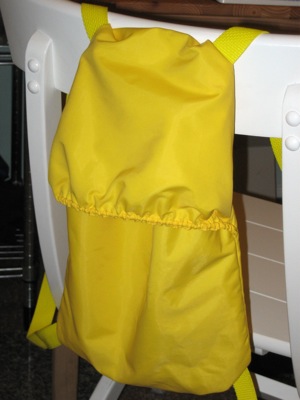I drafted another bag, an envelope close backpack, for the coated nylon:

I thought I would give it a go without sealing the seams, of which there are only two. Bad idea. Everything inside got damp. So now next time I am able to have the windows open (which would not be tonight) I’ll pull out the toxic seam sealant gunk and see what that does. I will likely have to seal both inside and outside because I stitched it together as one layer and it may not penetrate sufficiently just sealing the inside of the seam.
The bag is more-or-less an envelope close pillow cover with shoulder straps, there is a wide overlap you flip back over the top to open. This works well with soft squishy things. My pattern isn’t rectangular (it looks rather like some kind of award statuette because of the curved edge of the flap) but aside from that it’s constructed just the same.
I have to think about how I would make the lining separately. With the edges of the overlap stitched into the side seam I wouldn’t be able to get nicely finished elastic casings. I cut the two layers of fabric, stitched and turned the two short ends (edge of inside opening and edge of outside overlap) and inserted the elastics. That way I could catch both ends of the casings in the side seams and not have to hand-finish anything. Maybe if I sealed the seams from the inside before overcasting the seam allowances together.
To add lining inside the bag I’d have to put another stitching line across the top at the fold, that would be another place water could get in. The whole idea here was to have as few seams as possible. There must be some sort of second layer to protect the coating on the back of the nylon, it isn’t durable enough by itself and any damage means the rain protection is ruined.

